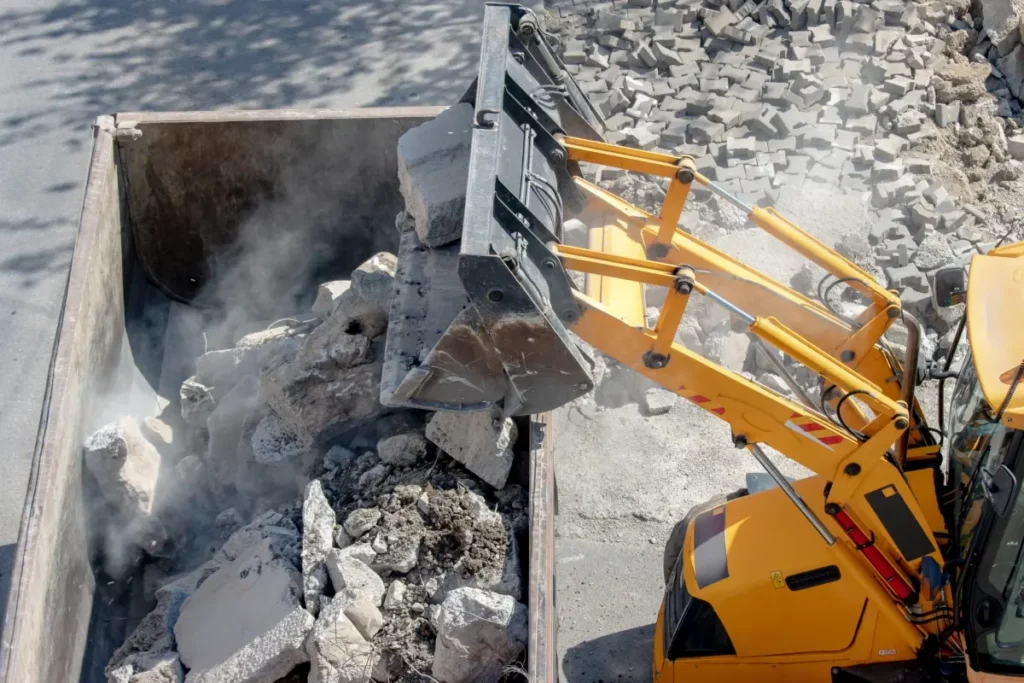It is 6:15 AM on a high-stakes commercial build. Permits are delayed, a scissor lift has not arrived, subcontractors are short-staffed, and crews are waiting on gear, instructions, and site access. The equipment team is scrambling to verify inspections, checkouts, and safety plans before work can begin.
These issues are not isolated; rather, they reflect deeper inefficiencies that affect productivity, timelines, and budgets across the board.
With construction output surpassing $13 trillion in 2023 and projected to grow another 70% by 2040, the demand for faster, smarter, and more efficient construction is intensifying. Waste, downtime, and miscommunication are no longer manageable side effects – they are liabilities.
This is where lean construction comes in, offering a structured approach to systematically reduce such inefficiencies. Rather than adding complexity, it focuses on streamlining workflows, reducing wastage, and keeping teams aligned from planning to execution.
Therefore, the clarity and coordination that lean construction brings to teams make it a powerful approach for boosting efficiency and productivity. But what exactly is lean construction, and what does it entail?
Let’s break it down.
What is lean construction?
Lean construction is a project delivery method that focuses on maximizing value while minimizing waste across every phase of the construction lifecycle. Inspired by lean manufacturing principles pioneered by Toyota in the mid-20th century, it adapts those ideas to the unique challenges of construction, where unpredictability, fragmentation, and high variability often get in the way of efficiency. It requires rethinking traditional workflows, evaluating inefficient routines, and aligning every part of the process to deliver better outcomes with fewer resources.
Such coordination becomes especially critical on complex jobs where tasks across teams are tightly linked and dependent on one another. For example, if steel erection wraps up early but the equipment needed for electrical rough-in has not arrived, the schedule gains quickly disappear.
Lean practices—like better look-ahead planning through updated task schedules and pre-coordinated equipment requests—help prevent those gaps, keeping crews moving and progress steady.
Lean construction defines clear goals that shape how projects, like the example above, are planned, resourced, and executed:
| Goal | Description |
| Elimination of wastage and non-value-adding tasks | Focuses on activities that directly contribute value, cutting out unnecessary steps and delays |
| Improved communication and collaboration | Enhances coordination between field teams, subcontractors, and office staff for smoother workflows. |
| Optimization of labour, tools, and equipment | Seeks efficient resource use to reduce idle equipment/time and bottlenecks. |
| Predictable high-delivery outcomes | Aims for consistent results that meet performance, safety, and client expectations. |
Check out our podcast on lean construction and discover how it eliminates waste and boosts productivity.
6 core principles of lean construction
Beyond its broad goals, lean construction is grounded in a set of core principles that guide how work is planned, coordinated, and carried out in the field. These principles offer a practical framework for teams looking to reduce inefficiencies, improve coordination, and deliver outcomes that align with project value.
Each one tackles a different facet of project delivery, and together, they lay the groundwork for more predictable, value-driven outcomes.

1. Deliver what matters
Lean construction starts by emphasizing value, delivering only what the end-user truly needs. For field teams, this means prioritizing core requirements over non-essential add-ons and ensuring the right equipment is available when and where it is needed. By cutting out non-critical elements, projects stay on track and resources are used where they matter most.
2. Keep work moving
Flow efficiency is about maintaining uninterrupted progress across crews, tasks, and equipment. Delays in one area, like a generator not arriving on time, can stall entire sequences of work and disrupt overall timelines.
For teams juggling multiple active sites, keeping operations in sync requires precise coordination and timely fulfillment. Lean construction addresses this by tightening coordination between teams and ensuring that equipment requests and deliveries are fulfilled precisely when required, maintaining steady progress on-site.
3. Cut the waste
Lean construction emphasizes eliminating tasks, materials, or processes that do not add direct value to the project. Common culprits include idle equipment, unnecessary movement, and time-consuming manual tracking.
Left unaddressed, these inefficiencies build up and quietly erode productivity. For instance, a forklift left unused due to unclear dispatch schedules or redundant paper-based log checks can drain both time and resources on site.
A lean approach would flag this early, using better planning and communication to ensure the right equipment is in use when and where it’s needed.
4. Improve as you go
The idea that better outcomes come from continuously refining how work is done is fundamental to lean construction. This principle encourages minor, frequent adjustments rather than occasional large-scale overhauls.
Streamlining material staging near active zones or fine-tuning crew handoffs between tasks are examples of subtle changes that, over time, drive greater site efficiency. A lean approach builds in space to reflect, reassess, and implement these improvements regularly, making each project more efficient than the last.
5. Respect the crew’s feedback
Respecting the crew means recognizing the value of frontline experience in shaping effective workflows. Those closest to the work are often best positioned to spot inefficiencies, safety concerns, or coordination issues early.
When field teams and equipment managers are brought into planning discussions from the beginning, they can surface risks and suggest adjustments before problems escalate. Lean construction supports such early collaboration by fostering stronger relationships between office and field teams, which are built on mutual respect and shared accountability.
6. Think like a system
Lean construction emphasizes viewing project delivery as an interconnected system, not a set of isolated responsibilities. Coordinated planning across teams, like procurement, logistics, and site crews, is essential to keeping work on track.
When schedules and requirements are aligned early, critical handoffs happen smoothly and avoid costly delays. Such a mindset ensures every role supports a shared plan, enabling more predictable progress on site.
The 8 wastes in construction
Minimizing waste is central to lean construction, and waste takes many forms on a jobsite. To help teams recognize and address these issues early, lean construction utilises a framework that classifies waste into eight distinct types.
Viewed through this lens, even modest adjustments in how equipment is requested, dispatched, or staged can add up to significant gains in efficiency and performance.

1. Overproduction
Overproduction occurs when equipment or materials are procured beyond what is immediately needed. Ordering extra gear “just in case” may seem cautious, but it often results in unused inventory taking up space and tying up budget.
On dynamic jobsites, this can crowd staging areas or confuse what is actively needed on site. It also increases the risk of maintenance delays or asset misplacement. A lean approach encourages aligning procurement closely with actual demand, so teams only bring in what supports the current phase of work.
2. Waiting
Waiting is one of the most visible forms of waste on a jobsite. When crews are ready but equipment has not arrived or when site conditions unexpectedly halt progress, both labor and machinery sit idle.
These disruptions stall workflows, trigger last-minute reshuffling, and create bottlenecks that derail tightly planned schedules. In high-stakes commercial builds, even short delays can cascade into missed milestones. Tackling this waste calls for smarter planning buffers, real-time visibility into field activity, and tighter coordination across teams.
3. Transportation
On complex sites with multiple superintendents and trades in motion, equipment can end up being moved prematurely or without a clear purpose, often due to visibility gaps or overlapping responsibilities. This leads to wasted time, added fuel use, and extra wear on machines.
For instance, a generator stationed on one end of the tarmac might be hauled across the site mid-morning, only to be needed back where it started by afternoon. Such avoidable movement not only strains resources but also increases the risk of safety incidents in high-traffic zones.
Minimizing this waste depends on stronger coordination across field teams and better visibility into asset locations and usage.
4. Overprocessing
Rechecking work, double-handling updates, and manually inputting data across systems are all forms of overprocessing.
“I take information (from Autodesk Construction Cloud), and we are required to do our daily reports for my company in another project management software called CMIC,” says Michael Carter, Project Superintendent at Stonebridge Constructors.
Even though site updates are already logged in ACC, Carter has to re-enter them for internal tracking. These extra steps reflect disjointed workflows that slow teams down. Lean construction eliminates such inefficiencies by aligning tools and reducing duplicative tasks.
5. Inventory
Inventory waste arises when tools and materials sit unused due to both excess and, especially, lack of visibility. On busy job sites, items are often shared, rotated, or stored across multiple areas, making it easy for gear to be overlooked.
As a result, teams may reorder what is already available, leading to duplicated stock and wasted spend. Idle inventory also clutters staging zones and complicates access to what is actually needed.
A lean approach emphasizes real-time tracking, so crews can locate and use existing resources before bringing more on-site.
6. Motion
Excessive motion is a hidden but costly waste on busy job sites. Crews often spend time walking the site to locate tools, verify equipment, or chase updates that could be shared digitally. Michael Carter says he spends 60–70% of his time walking the site, not only to supervise, but to ensure standards are met and “know what clean work looks like”.
In his case, that motion often reflects a lack of real-time updates or standardized workflows. Reducing motion starts with better equipment traceability and communication, so crews can get to work without unnecessary steps in between.
7. Defects
Equipment-related issues can be just as disruptive as design flaws when they result from poor maintenance. A malfunctioning lift or broken excavator can bring coordinated tasks to a halt, leaving crews unable to move forward.
These problems often trace back to missed inspections, incomplete service logs, or reactive upkeep. In high-pressure field conditions, such defects lead to downtime, frustrated teams, and schedule overruns.
Proactive inspections and up-to-date equipment maintenance records play a critical role in preventing downtime and keeping jobs on track.
8. Skills misuse
When skilled labor is tied up fixing equipment, tracking down missing tools, or handling routine logistics, its expertise is underutilized. Tasks that do not require trade-specific knowledge pull talent away from where it’s most valuable, i.e., building and solving complex site challenges.
This misalignment often happens when workflows lack structure or when crews are left to fill in gaps caused by poor coordination. Better planning and clearer task allocation, both core aspects of lean construction, help ensure that skilled crews stay focused on the work that actually drives progress.
Lean in practice: Equipment management tactics
After identifying sources of waste, the next step is applying practical strategies that embed lean thinking into day-to-day operations. Many jobsite delays and disconnects—like idle equipment, miscommunication, or out-of-sync teams—stem from fragmented equipment processes.
Introducing lean equipment management tactics helps close these gaps by improving visibility, streamlining coordination, and ensuring the right tools are available when and where they are needed.

1. Use pull-based equipment requests
Rather than sending equipment based on guesswork or past trends, pull-based requests ensure that tools and machinery are dispatched in direct response to actual site needs. This approach aligns with short-term planning tools like the Last Planner System (LPS), where foremen and superintendents coordinate daily or weekly requirements based on real progress.
For crews in the thick of shifting schedules and evolving scopes, this helps prevent staging areas from being clogged with unused gear. It also gives project leads clearer visibility into which equipment requests are essential and which can be deprioritized.
By letting the field drive demand, teams reduce overordering, free up equipment for other sites, and keep workflows tighter and more predictable.
2. Standardize inspections and transfers
Standardized inspections bring consistency to how equipment condition is assessed before and after use. Mobile-first checklists, paired with QR codes or RFID tags, make it easier for crews to log issues and track transfers in real time.
For example, scanning a skid steer when it arrives on site can confirm that it is inspection-ready and free of faults from its previous deployment. This reduces mid-task disruptions and helps ensure that only safe, functioning equipment is put into rotation.
3. Apply 5S and visual management principles
Organizing equipment using 5S principles, i.e., sort, set in order, shine, standardize, and sustain, helps jobsites run more smoothly day to day. Grouping tools by category, clearly labeling storage zones, and using color-coded tags to indicate equipment status make it easier for teams to find what they need and identify what is not ready for use.
Such visual controls reduce miscommunication during handoffs and minimize time lost searching for gear. In fast-paced field environments, even small steps like these support cleaner workflows and fewer delays.
4. Implement just-in-time delivery of tools and equipment
Coordinated, need-based delivery ensures that tools and equipment arrive precisely when required, keeping staging areas clear and operations streamlined. For field teams managing unpredictable schedules, this approach helps prevent inventory from piling up before it is usable.
It also limits wear caused by unnecessary handling or early exposure to site conditions. By aligning drop-offs with current site progress, supervisors and planners can maintain stronger control over equipment flow and responsiveness.
5. Digitize request and dispatch workflows
Digital systems streamline how equipment is requested, approved, and dispatched, making it easier to align supply with active project needs. When a foreman submits a request through a centralized platform, equipment managers can quickly check availability, approve assignments, and schedule deliveries without delays.
For example, if a forklift is scheduled for slab prep on Wednesday, the system ensures it is not assigned elsewhere or left idle the day before. These tools also help link dispatch planning to the broader project schedule, keeping workflows tight and on track.
By removing guesswork from the process, teams can respond faster and plan more confidently.
6. Join planning meetings and daily coordination huddles
When equipment managers participate in planning meetings and daily huddles, potential conflicts can be identified and resolved before they impact progress. These touchpoints create space to align on equipment availability, clarify responsibilities, and adjust to shifting timelines in real time.
They also strengthen coordination between field teams and support staff, reducing the likelihood of urgent rescheduling or delayed deliveries. Consistent involvement ensures that equipment workflows stay tightly integrated with broader project goals.
7. Use value stream mapping to pinpoint inefficiencies
Mapping out the full lifecycle of equipment – from request to return – helps uncover where delays or missteps occur. Value stream mapping provides a high-level view of how equipment moves through planning, dispatch, use, and return stages. By visualizing each step, teams can pinpoint where approvals stall, transfers lag, or tools sit unused between jobs.
These insights make it easier to cut out unnecessary steps, tighten coordination, and improve response times. The result is a more efficient and predictable equipment workflow that keeps crews moving without interruption.
Benefits of lean construction
When applied consistently, lean-aligned practices lead to tangible benefits across project sites. These improvements boost equipment reliability, enhance decision-making, and help teams operate with greater focus and fewer disruptions.
Below are some of the key outcomes teams can expect when waste is reduced and workflows are better aligned:
- Higher equipment uptime: Smarter scheduling and routine inspections help prevent breakdowns and keep machines in active use rather than sitting idle or waiting for repairs.
- Lower costs: By cutting down on waste, overordering, and rework, teams can protect thin margins and make more strategic purchasing decisions, which are crucial in a high-risk, low-margin industry where 44% of projects end at a loss.
- Faster project delivery: Better planning and reduced delays around equipment access mean crews spend less time waiting and more time building, keeping projects on track.
- Improved safety and decision making: Clearer equipment visibility and organized yards lower the risk of accidents, while connected systems support quicker, more informed responses to changing site conditions.
- Reduced environmental impact: Eliminating excess equipment and unnecessary engine hours results in lower fuel use and less overall waste across job sites.
- Better field productivity: When the right tools arrive when and where they are needed, crews can stay focused on meaningful work without unnecessary interruptions.
- More strategic focus: With fewer last-minute issues to solve, field and office teams can prioritize long-term planning, risk mitigation, and quality execution.
These outcomes reinforce the value of refining how equipment is planned, moved, and maintained across job sites. With fewer inefficiencies in the system, teams can stay focused on execution, adapt more easily to changing conditions, and maintain steady progress on site.
How to implement lean construction
To actualize the benefits of lean construction, teams need a structured approach to implementation. These gains do not come from isolated fixes but from consistent changes to how equipment and workflows are managed.
The following steps outline how to start embedding lean principles into your day-to-day operations:
1. Start with a pilot site or workflow
Begin by applying lean principles to a specific jobsite, project phase, or equipment-related process. Choosing a manageable scope makes it easier to measure impact, troubleshoot issues, and refine your approach. A successful pilot also builds internal buy-in and sets the foundation for broader adoption.
2. Map the workflow
Use value stream mapping to outline how equipment-related tasks progress across teams and phases. This high-level view helps uncover handoff delays, redundant steps, or unclear responsibilities that hinder flow.
3. Identify a change agent
Designate a team member to lead the lean initiative and coordinate efforts across functions. An effective change agent helps align departments, facilitate communication, and ensure that lean practices are carried through from planning to execution. This role is essential to turning lean goals into day-to-day operational habits.
4. Adopt pull planning and LPS
Incorporate pull planning practices into short-term scheduling tools, like Last Planner System (LPS), to align work with real-time site readiness. This ensures teams only commit to tasks that can realistically be completed, reducing delays and promoting accountability across crews.
5. Digitize and standardize
Replace fragmented, paper-based processes with mobile-first tools that centralize equipment requests, approvals, and tracking. Standardized digital workflows improve data accuracy, reduce response times, and make coordination more seamless across job functions.
6. Review and improve
Schedule regular post-phase reviews or retrosessions to assess what worked and/or underperformed, and where processes can improve. These sessions help teams spot recurring inefficiencies, surface feedback from the field, and fine-tune workflows for future phases.
Over time, this habit of reflection drives continuous improvement and reinforces lean thinking across projects.
Lean starts with smarter workflows
Implementing lean construction is not about radical overhauls but rather a steady commitment to refining how work gets done. When equipment processes are structured, digitalized, and aligned with project needs, teams can move from reactive fixes to more coordinated, confident execution.
Often, it is the smaller operational shifts, like digitizing checklists, standardizing equipment requests, or joining daily planning huddles, that gradually create lasting impact. These improvements reduce delays, improve field coordination, and support more consistent project delivery.
Revisit that early morning scenario: permits delayed, essential equipment unavailable, crews left waiting. Such disruptions point to underlying process inefficiencies, which lean practices are designed to address. With more visibility, tighter coordination, and proactive planning, those critical moments become easier to manage.
Software like EZO CMMS supports this transformation by helping teams plan maintenance, track utilization, and streamline equipment requests – all essential pieces of a lean-aligned equipment strategy.
Frequently Asked Questions
What is Lean Construction?
Lean Construction is a methodology to maximize value and reduce waste (time, materials, motion) by improving workflow, collaboration, and continuous improvement.
What are the core principles of Lean Construction?
Core principles include defining customer value, mapping the value stream, continuous flow, pull systems, reducing waste, respect for people, and continual improvement.
How does Lean differ from traditional construction management?
Lean focuses on collaboration, eliminating non-value steps, and fast feedback loops; traditional methods often push tasks regardless of readiness and accept waste as inevitable.
What kinds of waste exist in construction projects?
Common wastes: waiting, overproduction, excess motion, defects/rework, excess inventory, transport, unused talent, and overprocessing.
What is the Last Planner System (LPS) and why is it important?
LPS is a collaborative scheduling model involving all trades to commit to what they will deliver. It reduces uncertainty, improves downstream planning, and enhances reliability.
How does Lean construction improve project timelines?
By smoothing workflow, reducing delays/wait times, using pull-scheduling, better coordination between trades, and early issue detection.
What are challenges implementing Lean on construction sites?
Challenges include cultural resistance, lack of leadership buy-in, poor communication among stakeholders, insufficient training, ambiguity in roles, and legacy processes.
How do you measure success in Lean Construction?
Measure metrics like project delivery time vs plan, percentage of plan reliability, rework rates, waste volumes, cost savings, client satisfaction, and flow efficiency.
Is Lean Construction only for big projects or can small contractors benefit?
Small/mid contractors can benefit a lot: even simple lean tools (5S, pull planning, visual workflows) reduce cost/time. It scales to any size.
How much training is required for teams to adopt Lean Construction?
Enough that each stakeholder understands lean principles, tools (LPS, pull planning etc.), roles, and methods. Structured training + hands-on mentoring works best.
How do you start implementing Lean in a construction firm with no prior experience?
Start with profiling current workflows (map value stream), identify top 1-2 waste issues, run a pilot project, involve key trades early, measure, adjust, then expand.
What software/tools support Lean Construction practices?
Tools supporting scheduling, visual workflows, pull planning, continuous feedback, work tracking. Solutions like EZO’s CMMS and planning modules help enforce workflows and visibility.
How do you maintain continuous improvement in Lean Construction projects?
Regular retrospective meetings, data tracking (feedback, performance), involving everyone in problem-solving, documenting lessons learned, and iterating processes.
How does Lean handle change orders or design revisions?
Lean emphasizes early involvement of stakeholders to anticipate changes; when changes happen, impact analysis, frequent communication, and pull scheduling help absorb changes without large disruptions.
What is the role of supply chain and logistics in Lean Construction?
Crucial. Timely delivery (just-in-time), minimizing on-site storage, coordinating with suppliers, reducing transport delays and inventory waste.
Can Lean Construction help with safety and quality?
Yes. Fewer reworks and better planning reduce error risks; standard work and checklists help enforce quality; worker involvement enhances safety awareness.
What resistance do workers/subcontractors show to Lean, and how to overcome it?
Resistance often due to fear of extra work, lack of clarity, old habits. Overcome via training, showing quick wins, shared decision-making, and leadership modeling.
How does Lean Construction impact cost savings and profitability?
Lean reduces waste, delays, rework, material overuse; all these cut cost. Better reliability and efficiency often translate into higher profits and fewer budget overruns.
How often should you review Lean workflows or schedules on a project?
On-site daily huddles; weekly work-plan reviews; 6-week look-aheads; milestone/phase reviews monthly or at key project intervals.
What are real-world examples of Lean Construction success?
Examples include successful Last Planner System use, reduction in lead time, improved schedule reliability, cost savings from reduced rework, and better client satisfaction.
Was this helpful?
- What is lean construction?
- 6 core principles of lean construction
- The 8 wastes in construction
- Lean in practice: Equipment management tactics
- 1. Use pull-based equipment requests
- 2. Standardize inspections and transfers
- 3. Apply 5S and visual management principles
- 4. Implement just-in-time delivery of tools and equipment
- 5. Digitize request and dispatch workflows
- 6. Join planning meetings and daily coordination huddles
- 7. Use value stream mapping to pinpoint inefficiencies
- Benefits of lean construction
- How to implement lean construction
- Lean starts with smarter workflows
- Frequently Asked Questions
- What is Lean Construction?
- What are the core principles of Lean Construction?
- How does Lean differ from traditional construction management?
- What kinds of waste exist in construction projects?
- What is the Last Planner System (LPS) and why is it important?
- How does Lean construction improve project timelines?
- What are challenges implementing Lean on construction sites?
- How do you measure success in Lean Construction?
- Is Lean Construction only for big projects or can small contractors benefit?
- How much training is required for teams to adopt Lean Construction?
- How do you start implementing Lean in a construction firm with no prior experience?
- What software/tools support Lean Construction practices?
- How do you maintain continuous improvement in Lean Construction projects?
- How does Lean handle change orders or design revisions?
- What is the role of supply chain and logistics in Lean Construction?
- Can Lean Construction help with safety and quality?
- What resistance do workers/subcontractors show to Lean, and how to overcome it?
- How does Lean Construction impact cost savings and profitability?
- How often should you review Lean workflows or schedules on a project?
- What are real-world examples of Lean Construction success?





